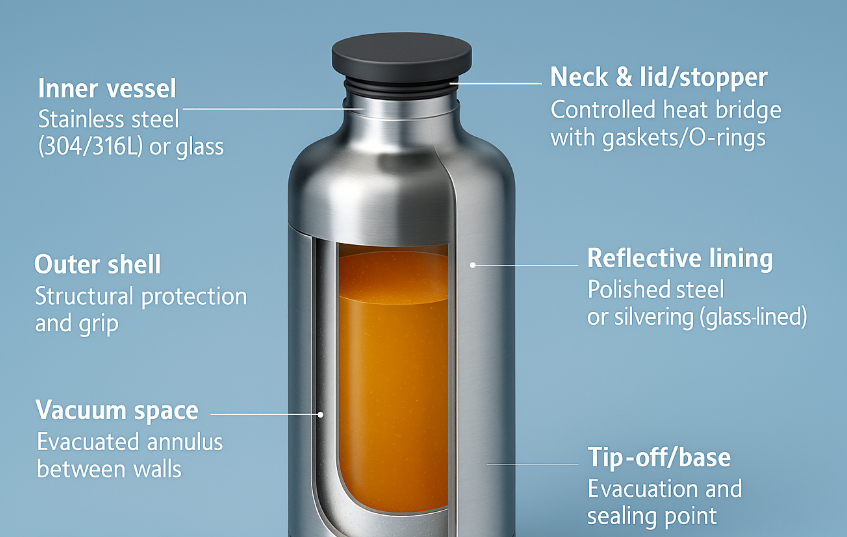How Does a Vacuum Flask Work?
Release time:2025-08-15
How Does a Vacuum Flask Work?
A vacuum flask (often called a Thermos) slows heat transfer with a double wall and an evacuated gap, low-emissivity surfaces to reflect radiation, and a well-sealed lid that minimizes the remaining heat pathway at the neck. In premium, hermetically sealed builds, lead-free, low-temperature sealing glass helps bond to stainless steel under vacuum, protecting vacuum quality and boosting thermal retention.
This guide explains what a vacuum flask is, how a vacuum flask works, how vacuum flasks are made, how a vacuum flask keeps liquids hot by preventing/reducing heat loss, what makes the best vacuum flask, and how to clean a vacuum flask.
Table of Contents
-
What is a vacuum flask?
-
How does a vacuum flask work?
-
Anatomy and materials
-
How are vacuum flasks made? (manufacturing overview)
-
Sealing glass for hermetic joints (lead-free, low-temp)
-
Performance: how long does it keep hot/cold?
-
Best-practice use: how to keep liquids hot longer
-
Failure modes & quality checks
-
Environmental impact & recyclability
- Reliable glass to metal seal manufacturers :SPCERA
-
FAQ
What Is a Vacuum Flask?
A vacuum flask is a double-walled container with the air removed from the gap between an inner vessel and an outer shell. With almost no gas in that space, conduction and convection are drastically reduced, while polished or silvered surfaces lower emissivity to cut radiative heat transfer. Result: hot drinks stay hot; cold drinks stay cold.
How Does a Vacuum Flask Work?
When it comes to how does the vacuum flask work, it blocks all three modes of heat transfer:
-
Conduction & Convection: The evacuated gap removes air pathways and stops bulk air motion.
-
Radiation: Low-emissivity (reflective) surfaces reflect infrared energy back toward the liquid.
-
Neck/Lid: Gaskets and an insulated stopper reduce the last deliberate “bridge” from inside to outside.
How Does a Vacuum Flask Keep Liquids Hot?
By eliminating air in the annulus and reflecting IR, the flask retains heat. A narrow neck and tight closure cut losses during use.
How Does a Vacuum Flask Prevent/Reduce Heat Loss?
-
Prevent: The vacuum gap prevents convection and minimizes conduction.
-
Reduce: Low-ε surfaces reduce radiation; good lid design reduces neck losses.
Anatomy and Materials
-
Inner vessel: Stainless steel (304/316L) or glass.
-
Outer shell: Structural protection and grip.
-
Vacuum space: The evacuated annulus between the two walls.
-
Reflective lining: Polished steel or silvering (glass-lined).
-
Neck & lid/stopper: The controlled heat bridge with gaskets/O-rings.
-
Tip-off/base: Where evacuation and sealing occur.

Stainless vs. glass-lined
-
Stainless: Durable, drop-resistant, outdoor-friendly; modern designs often add copper-plated patches or highly polished areas to lower emissivity.
-
Glass-lined: Excellent low emissivity and taste neutrality; fragile but outstanding thermal performance.
How Are Vacuum Flasks Made? (Manufacturing Overview)
-
Forming: Deep-draw the stainless inner and outer cups (or prepare a glass inner with protective shell).
-
Joining: Mate at the mouth to keep an annular gap.
-
Evacuation: Pump down through a small tube; some designs include a getter to capture residual gases.
-
Radiation control: Silvering (glass) or highly polished steel to reduce emissivity.
-
Sealing: Close the evacuation tube (pinch/weld for steel); hermetic assemblies may use lead-free, low-temperature sealing glass (see Section 5).
-
Finishing & QA: Surface finishing, lid/gasket assembly, then thermal retention and leak tests.
Sealing Glass for Hermetic Joints (Lead-Free, Low-Temp)
Hermetic integrity directly affects how a vacuum flask works by preserving vacuum quality and minimizing heat leaks at glass-to-metal interfaces (e.g., specialty closures or liner assemblies). Your lead-free systems and process windows are integrated below:
| Sealing glass system | Vacuum sealing window | Bonding to stainless | Core benefits | Typical notes |
|---|---|---|---|---|
| Bismuthate (Bi-based) | 580–600 ℃ | Strong wetting & adhesion | Helps reach higher vacuum; stable retention | Robust joints where vacuum stability and strength are prioritized |
| Phosphate (P-based) | 520–550 ℃ | Reliable bonding | Lead-free, lower temp, eco-friendly; perfect replacement for leaded glass | Lower thermal stress; good for thin-wall parts and automated lines |
Why it matters: Lower, lead-free sealing temperatures protect stainless structures, improve joint reliability, and help maintain a high vacuum—translating to longer heat retention and better consumer experience.
Performance: How Long Will It Keep Hot/Cold?
Depends on:
-
Vacuum level and its stability over time
-
Surface emissivity (reflective lining quality)
-
Neck/lid design and gasket condition
-
Volume & fill ratio (fuller = slower temperature change)
-
Starting vs. ambient temperatures
Modern builds often claim 12–24 h hot and 24–48 h cold (indicative; actual results depend on the above factors).
Best-Practice Use: Keep Liquids Hot Longer
-
Pre-heat / pre-chill: 3–5 min with hot/cold water.
-
Fill it up: Less headspace = less internal convection.
-
Close promptly & tightly: Minimize warm/cold air exchange.
-
Limit opening frequency: Decant into a cup if possible.
-
Hygiene: Clean seals and lid channels; dry fully with the cap off.
Failure Modes & Quality Checks
-
Vacuum loss: Dents or micro-cracks near the tip-off admit air → big performance drop.
-
Seal aging: Gasket hardening increases neck heat leak.
-
Coating damage: Scratches raise emissivity, increasing radiation.
Simple home test: Fill with ~90–95 ℃ water; measure temperature drop at 6 h and 24 h vs. your spec. Exterior should stay cool away from the neck.
Environmental Impact & Recyclability
A durable flask replaces hundreds of disposable cups. Prefer BPA-free contact parts, lead-free hermetic materials, and replaceable gaskets. Stainless bodies are widely recyclable; policies for glass-lined units vary.
Reliable glass to metal seal manufacturers :SPCERA
When it comes to high-quality glass-to-metal seals, SPCERA is a trusted name, known for delivering advanced solutions that are critical for the performance and durability of products such as vacuum flasks. These seals are designed to create a secure, long-lasting bond between glass and metal, ensuring optimal thermal insulation and airtight integrity—vital properties for vacuum flasks that are meant to keep liquids at their desired temperature for hours.
SPCERA employs cutting-edge technology and precise engineering to produce glass-to-metal seals that can withstand extreme conditions, including high temperatures and fluctuating pressures. This makes them a reliable choice for applications that require durability and precision, such as in vacuum flask production.
In vacuum flasks, the glass-to-metal seal plays a crucial role in maintaining the vacuum layer between the inner and outer walls of the flask. This vacuum layer is key to the flask’s ability to retain heat or cold by providing excellent thermal insulation. By ensuring the integrity of this vacuum seal, SPCERA helps manufacturers produce vacuum flasks that offer exceptional performance in keeping beverages hot or cold for extended periods.
SPCERA’s expertise in glass-to-metal sealing ensures that your vacuum flasks are built to last, providing superior insulation, durability, and overall functionality. Whether you are designing high-end thermos flasks or industrial-grade thermal containers, SPCERA’s seals are an essential component to achieving high-performance products.
FAQ
Q1. What is the best vacuum flask?
The best choice balances vacuum retention, low-emissivity lining, insulated lid, capacity for your day, and durability (stainless for drops; glass-lined for taste neutrality).
Q2. How a vacuum flask works vs. a regular bottle?
Single-wall bottles allow conduction and convection; a vacuum flask’s evacuated gap blocks both and reduces heat loss via low-ε surfaces.
Q3. Which sealing materials are used in hermetic joints?
Many premium designs use lead-free, low-temperature sealing glass that bonds to stainless under vacuum: Bi-based (580–600 ℃) for excellent wetting/vacuum stability, and P-based (520–550 ℃) for lower-temperature, eco-friendly processing that replaces leaded glass.
Q4. Why does the area near the lid feel warm?
It’s the necessary structural bridge; high-quality gaskets and lid geometry minimize this path.
How to Clean a Vacuum Flask (Step-by-Step)
-
Rinse immediately after use with warm water.
-
Soak with warm water + a small drop of mild, fragrance-free detergent 10–15 min.
-
Brush the inner wall and lid channels with a bottle brush.
-
Rinse thoroughly until no suds remain.
-
De-odorize (as needed): Warm water + 1 tsp baking soda; for stains add a splash of white vinegar; rinse well.
-
Air-dry with the lid off.
Do not use bleach/chlorine on stainless, don’t freeze with liquid inside, and avoid abrasive pads that can scratch and raise emissivity.






